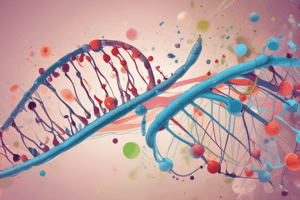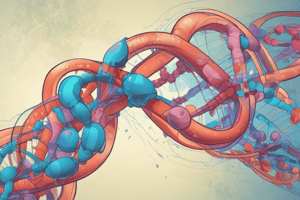Podcast
Questions and Answers
What is the main function of RNA in protein synthesis?
What is the main function of RNA in protein synthesis?
- To act as a bridge between DNA and protein synthesis (correct)
- To transcribe DNA into proteins
- To synthesize proteins directly from DNA
- To replicate DNA
What is the specific sequence of nucleotides in a gene responsible for?
What is the specific sequence of nucleotides in a gene responsible for?
- Terminating translation
- Initiating translation
- Determining the primary structure of proteins (correct)
- Forming peptide bonds
What is the outcome of transcription of a protein-coding gene?
What is the outcome of transcription of a protein-coding gene?
- Formation of a peptide bond
- Replication of DNA
- Production of a messenger RNA (mRNA) molecule (correct)
- Synthesis of a protein
What is the nitrogenous base that substitutes for thymine in RNA?
What is the nitrogenous base that substitutes for thymine in RNA?
What is the sugar molecule found in RNA?
What is the sugar molecule found in RNA?
What is the process by which DNA directs protein synthesis?
What is the process by which DNA directs protein synthesis?
What is the role of nucleotide monomers in DNA or RNA?
What is the role of nucleotide monomers in DNA or RNA?
What is the outcome of the initiation stage of transcription?
What is the outcome of the initiation stage of transcription?
What lies between coding regions in eukaryotic genes and their RNA transcripts?
What lies between coding regions in eukaryotic genes and their RNA transcripts?
What is the purpose of RNA splicing?
What is the purpose of RNA splicing?
What is the function of transfer RNA (tRNA)?
What is the function of transfer RNA (tRNA)?
What is the role of the anticodon on a tRNA molecule?
What is the role of the anticodon on a tRNA molecule?
How does a cell obtain the 20 amino acids available in its cytoplasm?
How does a cell obtain the 20 amino acids available in its cytoplasm?
What is the process of translating a genetic message into a polypeptide called?
What is the process of translating a genetic message into a polypeptide called?
What is the result of the process of translation?
What is the result of the process of translation?
How does the genetic message get translated into a polypeptide?
How does the genetic message get translated into a polypeptide?
What is the outcome of the process of translation?
What is the outcome of the process of translation?
What is the role of initiation factors during initiation of translation?
What is the role of initiation factors during initiation of translation?
During elongation, what is the energy source for each addition of an amino acid?
During elongation, what is the energy source for each addition of an amino acid?
What is the function of the small ribosomal subunit during initiation of translation?
What is the function of the small ribosomal subunit during initiation of translation?
How does the small ribosomal subunit bind with the mRNA in eukaryotes?
How does the small ribosomal subunit bind with the mRNA in eukaryotes?
What is the role of GTP hydrolysis during codon recognition?
What is the role of GTP hydrolysis during codon recognition?
How many stages are involved in the process of translation?
How many stages are involved in the process of translation?
What is the amino acid carried by the initiator tRNA during initiation of translation?
What is the amino acid carried by the initiator tRNA during initiation of translation?
Flashcards are hidden until you start studying
Study Notes
Overview of Gene Expression
- Gene expression is the process by which DNA directs protein synthesis, consisting of two stages: transcription and translation
- Proteins are the link between genotype and phenotype
- RNA is the bridge between DNA and protein synthesis, having a similar structure to DNA but with ribose instead of deoxyribose and uracil instead of thymine
Transcription
- During transcription, a DNA strand provides a template for the synthesis of a complementary RNA strand
- The process produces a messenger RNA (mRNA) molecule
- Transcription of a protein-coding gene produces a complementary RNA strand
Translation
- Translation is the process of building a polypeptide, consisting of three stages: initiation, elongation, and termination
- All three stages require protein "factors" that aid in the translation process
- Initiation involves the binding of mRNA, a tRNA with the first amino acid, and the two ribosomal subunits
- The small ribosomal subunit binds with mRNA and a special initiator tRNA, which carries methionine
- Elongation involves the addition of amino acids one by one to the growing chain, requiring energy expenditure and codon recognition
RNA Splicing
- Most eukaryotic genes and their RNA transcripts have long noncoding stretches of nucleotides called introns, which lie between coding regions (exons)
- RNA splicing removes introns and joins exons to create an mRNA molecule with a continuous coding sequence
- The signal for RNA splicing is a short nucleotide sequence at each end of an intron
Transfer RNA (tRNA)
- tRNA molecules are translators, translating a particular mRNA codon into a particular amino acid
- Each tRNA molecule bears a specific amino acid at one end and a nucleotide triplet called an anticodon at the other end, which base-pairs with a complementary codon on mRNA
- tRNA molecules are transcribed from DNA templates, reading a nucleic acid word (the mRNA codon) and interpreting it as a protein word (the amino acid)
Studying That Suits You
Use AI to generate personalized quizzes and flashcards to suit your learning preferences.




